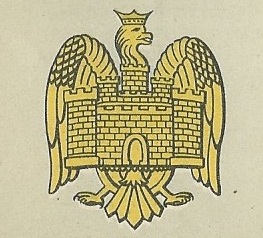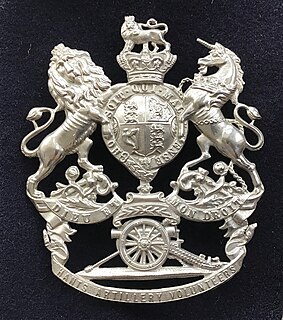 W
WThis list of regiments of the Royal Artillery covers the period from 1938, when the RA adopted the term 'regiment' rather than 'brigade' for a lieutenant-colonel's command comprising two or more batteries, to 1947 when all RA regiments were renumbered in a single sequence.
 W
WThis list of regiments of the Royal Artillery covers the period from 1938, when the RA adopted the term 'regiment' rather than 'brigade' for a lieutenant-colonel's command comprising two or more batteries, to 1947 when all RA regiments were renumbered in a single sequence.
 W
WThis list of regiments of the Royal Artillery covers the period from 1938, when the RA adopted the term 'regiment' rather than 'brigade' for a lieutenant-colonel's command comprising two or more batteries, to 1947 when all RA regiments were renumbered in a single sequence.
 W
WThe Edinburgh City Artillery was a part-time unit of Britain's Volunteer Force raised in the City of Edinburgh in 1859. It was the parent unit for a number of batteries in the later Territorial Force, including heavy batteries of the Royal Garrison Artillery that fought on the Western Front during World War I. It later formed a heavy regiment that served in the Battle of France and the campaign in North West Europe during World War II, while a spin-off medium regiment fought in Sicily and Italy. Its successor units continued in the postwar Territorial Army until the 1960s.
 W
WThe Bedfordshire Yeomanry was a Yeomanry regiment of the British Army. Serving intermittently between 1797 and 1827, it was re-raised in 1901 for the Second Boer War. It participated in the First World War before being converted to an artillery regiment. It served in the Second World War. Its lineage was maintained by 201 Battery, 100th (Yeomanry) Regiment Royal Artillery until that unit was placed in suspended animation in 2014.
 W
WThe 7th London Brigade, Royal Field Artillery was a new unit formed when Britain's Territorial Force was created in 1908. Its origin lay in Artillery Volunteer Corps formed in West London in the 1860s, which had later been incorporated into a larger London unit. Together with its wartime duplicate it served on the Western Front, at Salonika and in Palestine during World War I. It formed several units for service in World War II, when they were in action in North Africa, Italy and North West Europe. The unit continued in the postwar Territorial Army until 1961.
 W
WThe 1st Staffordshire Artillery Volunteers, later 2nd North Midland Brigade, was a Volunteer unit of the Royal Artillery of the British Army recruiting primarily from Staffordshire that fought on the Western Front during the First and Second World Wars in the Normandy Campaign and Belgium, Holland, and Germany.
 W
WThe South Nottinghamshire Hussars is a unit of the British Army formed as volunteer cavalry in 1794. Converted to artillery in 1922, it presently forms part of 103 Regiment, Royal Artillery.
 W
WThe 1st Cornwall Artillery Volunteers were formed in 1860 as a response to a French invasion threat. They served as a Coast Artillery unit during both World Wars, and also manned batteries serving overseas. The unit continued in existence until the dissolution of Coast Artillery in the UK in 1956.
 W
WThe Clyde Royal Garrison Artillery and its successors were Scottish part-time coast defence units of the British Army from 1910 to 1967. Although they unit saw no active service, they supplied trained gunners to siege batteries engaged on the Western Front during World War I.
 W
WThe 2nd Devonshire Artillery Volunteers was a unit of the British Volunteer Force and Territorial Army. The unit and its successors defended Plymouth Dockyard and the Devon coast from 1861 to 1961.
 W
WThe 1st Dorsetshire Artillery Volunteers and its successors were part-time coast defence units of the British Army from 1859 to 1956. Although these units saw no action, they protected the Dorset Coast, including the naval base of Portland Harbour, in both World Wars and also supplied trained gunners to siege batteries engaged on the Western Front during World War I. The unit continued in the Territorial Army after World War II.
 W
WThe East Riding Royal Garrison Artillery (ERRGA) was a part-time unit of Britain's Royal Artillery based at Hull in the East Riding of Yorkshire. It provided coastal defence artillery along the Humber Estuary from 1908 to 1956, manned siege batteries on the Western Front during World War I at the Somme and Ypres and played a role in the pursuit of the German army during the Hundred Days Offensive. It served as infantry in Allied-occupied Germany after World War II. Its successor units in the Territorial Army included anti-aircraft artillery and field engineers.
 W
WThe North Scottish Royal Garrison Artillery and its successors were Scottish part-time coast defence units of the British Army from 1908 to 1961. Although the unit saw no active service, it supplied trained gunners to siege batteries engaged on the Western Front during World War I.
 W
WThe Forth Royal Garrison Artillery and its successors were Scottish part-time coast defence units of the British Army from 1908 to 1956. Although they saw no active service, they supplied trained gunners to siege batteries engaged on the Western Front during World War I.
 W
WThe 2nd Glamorganshire Artillery Volunteers was a part-time unit of the British Army that defended the coast of South Wales from 1890 to 1942. Although it never saw action in its coastal defence role, it formed several siege batteries of heavy howitzers for service on the Western Front and Italian Front in World War I.
 W
WThe 1st Hampshire Artillery Volunteers and its successors were part-time coast defence units of the British Army from 1860 to 1967. Although the units saw no action, they protected the Portsmouth area in both World Wars and supplied trained gunners to siege batteries engaged on the Western Front during World War I. The unit continued in the Territorial Army after World War II.
 W
WThe 1st Lancashire Artillery Volunteers, popularly known as 'Brown's Corps', was an auxiliary unit of the British Army raised in Liverpool in 1859. As the Lancashire & Cheshire Royal Garrison Artillery in the Territorial Force it was responsible for defending the Mersey Estuary and the coastline of North West England. It was one of the few coast defence units to fire a shot during World War I but also provided personnel for a number of siege batteries that saw action on the Western Front. It continued in the coast defence role during World War II, at the end of which it sent troops to work in the rear areas in Europe. It was reformed postwar but was broken up when the coast artillery branch was abolished in 1956.
 W
WThe Orkney Heavy Regiment was a Territorial Army unit of Britain's Royal Artillery raised in the Orkney Islands just before World War II. During the war it was greatly expanded to defend the vital naval base of Scapa Flow. It was reformed postwar and later became an air defence battery.
 W
WThe Pembroke Royal Garrison Artillery was a part-time unit of the British Army that defended the coast of West Wales during both world wars. Although it never saw action in its coastal defence role, it manned a number of siege batteries of heavy howitzers for service on the Western Front and Italian Front in World War I.
 W
WThe 1st Suffolk & Harwich Volunteer Artillery, later the Essex & Suffolk Royal Garrison Artillery was an auxiliary coastal artillery unit of the British Army first raised in 1899. It defended the ports and naval bases around the estuaries of the Rivers Orwell and Stour. Although the unit saw no active service, it supplied trained gunners to siege batteries engaged on the Western Front during World War I. It was greatly expanded in World War II to defend the invasion-threatened East Anglian Coast from Harwich to Great Yarmouth. Postwar it continued in the coast and air defence roles until it disappeared in a series of amalgamations from the 1950s.
 W
WThe Thames and Medway Coast Artillery, which at its peak comprised three full regiments, was formed in Britain's Territorial Army in 1932 to man coastal defence guns on both banks of the Thames Estuary. It served in this role during World War II, at the end of which it sent troops to work in the rear areas in Europe. It was reformed postwar but was broken up when the coast artillery branch was abolished in 1956.